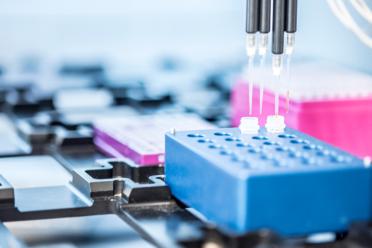Precision engineering: Genomics
When once we could only blindly cross-breed our domesticated animal and plant species, we are now in an era of synthetic biology: applying engineering to biotechnology.
At EI, we recently heard from Dr Anthony West - automation specialist in our Platforms & Pipelines group - who filled us in on the power and technical difficulties of a new approach to biotechnology: Synthetic Biology.
It wasn’t long ago, in natural history terms, that cattle were wild and humans roamed the African savannahs. Yet, over the last ten thousand years or so, we have harnessed nature to improve our chances at survival. After a laboriously slow process of domestication, our cows are now miniscule compared to their wild ancestors and roam only where we lead.
In the words of Richard Feynman - “What I cannot create, I do not understand.”
This rings especially true in the world of Synthetic Biology. Biological systems are complex and we have hardly even begun to understand them even though we have been tinkering for many thousands of years, making massive changes to the genomes of domesticated plants and animals (without really knowing the effects this might have on a genome-wide scale).
The challenges that present from this are clear to us, today. Our most important crop plants, though abundant in grain, are lacking in natural resistance to pests and disease and our thoroughbred dogs suffer from a suite of genetic ailments.
Synthetic biology, however, is defined as the application of the the principles of engineering to biological systems to enable us to design and program biological systems predictably.
The issue at the moment is that data on how systems function is scattered and disjointed; we don’t have the full picture of how everything in a biological system or network interacts, therefore we have to build first, collect more data about the system and then use it to improve the design. The more data we collect, the more we learn about the system.
Compare this to the computerised design of aircraft, for example. Aeroplane engineers have abundant data and massive catalogues of parts for which the function has been tested and defined as well as rules to define the ways that different parts and materials can be used together. These can be applied in order to design models, which are tested for functionality before production. When it becomes time to manufacture the aircraft, it will almost certainly work.
Synthetic biology is aiming to get to that stage for biological systems - to produce models that can be used to refine design. Any modelling process requires us to start with the very basics, and then add in parameters as we gain more information. This is an invaluable tool with which to drive forward the field of synthetic biology.

This is an invaluable tool with which to drive forward the field of synthetic biology.


One method is to reduce the genetic pack to its most basic level. While we are edging closer to being able to design a plant or a human genome from scratch, the process has already been demonstrated in bacteria.
Researchers at the Craig Venter Institute have gained worldwide renown in this field. They assembled the first genome from synthetic DNA, and have since synthesised a functioning, reduced living organism.
We have automated systems that enable us to rapidly chop and change DNA sequences. In our DNA fabrication pipeline at the EI DNA Foundry, we are using miniaturised liquid volumes handled by robotic systems to accurately, efficiently and cost-effectively assemble DNA sequences to any design.
Large DNA molecules are assembled from short, standardised blocks of DNA, sometimes known as BioBricks or, for plants, PhytoBricks, that are joined together in a standardised process. These are basic genetic elements that make up genes: coding regions of DNA along with the sequences that regulate their expression.
In the last century our ability to breed domesticated species of both animals and crops has accelerated rapidly. Synthetic biology has provided us with tools that allow us to target the specific gene sequences that cause a characteristic, and guide the selection process more swiftly along compared to the tick of nature’s more steady molecular clock.
The power of Genome Engineering is clear. We can produce more efficient, higher yielding varieties of crops that are more resistant to pests and disease with relatively consummate ease.
Now that we can make precise changes to a genome, we can generate crops with beneficial traits while avoiding carry-through of those that are undesirable. Similarly, we can identify and target more desirable mutations through phenotypic screening and, using genome engineering, apply these to our breeding programmes.
Thankfully, the toolkit that enables the advancement of biotechnology is evolving alongside our ability to imitate nature itself.
One example is a more refined and accurate method of delivering bespoke changes to a genetic sequence. The most favoured tool at the moment is RNA-guided Cas9 from the CRISPR immune systems of bacteria - yet this can yield unwanted off-site effects.
However, these can be avoided, either by applying advanced computing to aid good experimental design or by using improved versions of the tool. One improvement uses two modified versions of Cas9, each of which targets a separate strand of the DNA helix, thus doubling the length of sequence required for the tool to produce a change.


Synthetic biology has provided us with the tools to target the specific gene sequences that cause a characteristic, and guide the selection process more swiftly along compared to the tick of nature’s more steady molecular clock.

Along with the dream comes a dose of reality - and with power comes great responsibility.
We are, after 14,000 years of shuffling the genetic pack of our crops and domestic animals, essentially at the stage at which we can begin to master the art of guiding nature’s path. If it is possible to engineer superior plants then it is it can also possible to engineer and generate evolved humans. The latter has helped save a baby from leukaemia but could potentially be used to engineer embryos, as well as to cure those with inherited diseases.
Genome editing in human embryos using current technologies could have unpredictable effects on future generations. This makes it dangerous and ethically unacceptable and it has therefore only been permitted in one study so far. Even then the embryos cannot be implanted into a woman or kept for longer than 14 days.
The ethical questions, going forwards, are abundant but there are dedicated organisations, including the Research Ethics Committees, who ensure that all research is conducted in accordance with UK law and ethically approved by an independent review. At the international scale, organisations such as the BioBricks Foundation and iGEM have a mission to ensure an open and ethical approach to Synthetic Biology and help to educate students in responsible innovation.
Going forwards, at EI we aim to expand our national capability into developing a screening pipeline for synthetic DNA sequences that, in addition to our fabrication facility, will vastly increase our ability to generate and deploy improved microbes and plants in order to help answer a suite of biological challenges.
“Synthetic biology and precision genome engineering are a new paradigm for biological research - affecting everything from crop genetics to human health. This is supported by the £1.9M investment by the BBSRC at the Earlham Institute to set up our DNA foundry lab,” said Dr Daniel Swan, Head of our Platforms & Pipelines Group at EI.
“We can now both read and write DNA at scale, we have the technologies to measure the effects of those changes, understand them within the context of a system and provide a toolbox for researchers to explore living systems more deeply than ever before.”
Also known as bioengineering, synthetic biology is the application of engineering principles to biology. These principles include standardisation, automation, abstraction and characterisation to provide DNA catalogues detailing specific functions which have been tested and described. Machines can then automate the assembly of these DNA parts according to designs provided by synthetic biologists.
These are examples of standards being applied to biology. DNA parts that exist as BioBricks (the first biological standard) or PhytoBricks (the plant standard) can be joined together according to ‘assembly standards’. This allows for efficient and cost-effective DNA assembly automation, where scientists can easily exchange and reuse DNA parts in new experiments.
Also known as Genetic Modification (GM), this usually refers to the introduction of DNA prepared outside the organism into the genome of a living cell. Insulin used to treat diabetes is produced in genetically engineered bacteria, and some crops have been genetically engineered to deter or kill pests in order to reduce the amount of chemicals that need to be sprayed on them.
The changing of one or more DNA bases in the genome of a living organism. Mutations occurs naturally and contributes to the natural variation that we find within species. However, to increase genetic diversity, humans have used radiation and chemicals to induce genetic mutations in plants for almost a century. Plants with desirable characteristics are identified from mutagenised populations and new varieties are bred from these isolates. Thousands of crop varieties have been produced in this way but it is only the past couple of decades that we have been able to identify which genes have been mutated. Plants produced using these techniques are not classified as GM.
The use of molecular tools such as CRISPR/Cas9 that can be programmed to recognise specific sequences of DNA. These tools can be used to make changes to the genomes of living organisms. Much like radiation and chemical mutagenesis, genome engineering tools can be used to make very small mutations without introducing any new DNA sequences. However, these mutations will be in the targeted DNA sequence that the tools have been programmed to recognise. When a small but specific re-coding of an existing DNA sequence is made, this known as Genome Editing. Genome engineering tools can also be used for more precise Genetic Engineering, allowing new DNA to be inserted in a particular position.